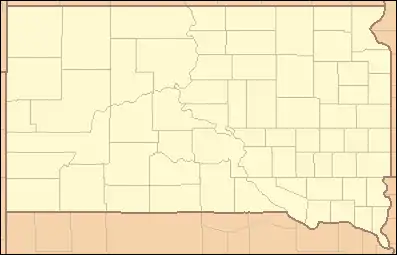United States District Court for the District of South Dakota
The United States District Court for the District of South Dakota (in case citations, D.S.D.) is the United States District Court or the Federal district court, whose jurisdiction for issues pertaining to federal law or diversity for the state of South Dakota. The court is based in Sioux Falls with other courthouses in Rapid City, Pierre, and Aberdeen. The district was created in 1889, when the Dakota Territory was divided into North and South Dakota.
| United States District Court for the District of South Dakota | |
|---|---|
| (D.S.D.) | |
 | |
 | |
| Location | Federal Building and United States Courthouse |
| Appeals to | Eighth Circuit |
| Established | November 2, 1889 |
| Judges | 3 |
| Chief Judge | Roberto Lange |
| Officers of the court | |
| U.S. Attorney | Ron A. Parsons Jr. |
| U.S. Marshal | Daniel C. Mosteller |
| www | |
Appeals from the District of South Dakota are taken to the United States Court of Appeals for the Eighth Circuit (except for patent claims and claims against the U.S. government under the Tucker Act, which are appealed to the Federal Circuit).
The United States Attorney's Office for the District of South Dakota, represents the United States in civil and criminal litigation in the court. The current United States Attorney for the District of South Dakota is Ron A. Parsons Jr.
Current judges
As of January 1, 2020:
| # | Title | Judge | Duty station | Born | Term of service | Appointed by | ||
|---|---|---|---|---|---|---|---|---|
| Active | Chief | Senior | ||||||
| 16 | Chief Judge | Roberto Lange | Pierre | 1963 | 2009–present | 2020–present | — | Obama |
| 14 | District Judge | Karen Schreier | Sioux Falls | 1956 | 1999–present | 2006–2013 | — | Clinton |
| 15 | District Judge | Jeffrey L. Viken | Rapid City | 1952 | 2009–present | 2013–2019 | — | Obama |
| 10 | Senior Judge | John Bailey Jones | inactive | 1927 | 1981–1995 | 1991–1994 | 1995–present | Reagan |
| 12 | Senior Judge | Lawrence L. Piersol | Sioux Falls | 1940 | 1993–2009 | 1999–2005 | 2009–present | Clinton |
| 13 | Senior Judge | Charles B. Kornmann | Aberdeen | 1937 | 1995–2008 | — | 2008–present | Clinton |
Vacancy and pending nomination
| Seat | Prior Judge's Duty Station | Seat last held by | Vacancy reason | Date of vacancy | Nominee | Date of nomination |
|---|---|---|---|---|---|---|
| 5 | Rapid City | Jeffrey L. Viken | Senior status | October 1, 2021[1] | – | – |
Former judges
| # | Judge | State | Born–died | Active service | Chief Judge | Senior status | Appointed by | Reason for termination |
|---|---|---|---|---|---|---|---|---|
| 1 | Alonzo J. Edgerton | SD | 1827–1896 | 1889–1896[Note 1] | — | — | B. Harrison | death |
| 2 | John Emmett Carland | SD | 1853–1922 | 1896–1911[Note 2] | — | — | Cleveland | elevation to 8th Cir. |
| 3 | James Douglas Elliott | SD | 1859–1933 | 1911–1933 | — | — | Taft | death |
| 4 | Alfred Lee Wyman | SD | 1874–1953 | 1929–1953 | — | — | Hoover | death |
| 5 | George Theodore Mickelson | SD | 1903–1965 | 1953–1965[Note 3] | 1954–1965 | — | Eisenhower | death |
| 6 | Axel John Beck | SD | 1894–1981 | 1958–1969 | 1965–1966 | 1969–1981 | Eisenhower | death |
| 7 | Fred Joseph Nichol | SD | 1912–1996 | 1965–1980 | 1966–1980 | 1980–1996 | L. Johnson | death |
| 8 | Andrew Wendell Bogue | SD | 1919–2009 | 1970–1985 | 1980–1985 | 1985–2009 | Nixon | death |
| 9 | Donald James Porter | SD | 1921–2003 | 1979–1992 | 1985–1991 | 1992–2003 | Carter | death |
| 11 | Richard Howard Battey | SD | 1929–2017 | 1985–1999 | 1994–1998 | 1999–2017 | Reagan | death |
- Recess appointment; formally nominated on December 16, 1889, confirmed by the United States Senate on January 16, 1890, and received commission the same day
- Recess appointment; formally nominated on December 8, 1896, confirmed by the Senate on December 15, 1896, and received commission the same day
- Recess appointment; formally nominated on January 11, 1954, confirmed by the Senate on February 9, 1954, and received commission on February 10, 1954
Chief judges
Chief judges have administrative responsibilities with respect to their district court. Unlike the Supreme Court, where one justice is specifically nominated to be chief, the office of chief judge rotates among the district court judges. To be chief, a judge must have been in active service on the court for at least one year, be under the age of 65, and have not previously served as chief judge. A vacancy is filled by the judge highest in seniority among the group of qualified judges. The chief judge serves for a term of seven years or until age 70, whichever occurs first. The age restrictions are waived if no members of the court would otherwise be qualified for the position.
When the office was created in 1948, the chief judge was the longest-serving judge who had not elected to retire on what has since 1958 been known as senior status or declined to serve as chief judge. After August 6, 1959, judges could not become or remain chief after turning 70 years old. The current rules have been in operation since October 1, 1982.
Succession of seats
|
|
|
|
| ||||||||||||||||||||||||||||||||||||||||||||||||||||||||||||||||||||
